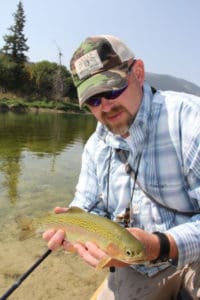By David Hart
If there’s nothing more thrilling than watching a trout inhale a dry fly, there’s nothing more frustrating than watching a dry fly drift across the water untouched.

Trout that aren’t feeding on top will rarely turn down a nymph below the surface, whether in moving or still water.
The good news is that a trout is almost always willing to eat. They just won’t eat a bug on the surface. That’s why every trout angler should keep a box filled with nymphs. More important, they should be willing to use them. There’s no better way to become proficient at nymphing than by doing it. And there’s no better time to fish a nymph than during the warmer months when the fish are most active.
It’s understandable why so many fishermen shy away from nymphs. There’s no dramatic rise of fish inhaling a dry fly. Worse, they can be somewhat difficult to fish. You not only can’t see the take, you can’t feel it, either.
Watch Your Bobber
A strike indicator takes care of that. They are nothing more than what most fishermen call a bobber and come in a variety of sizes and materials. What you use is less important than actually using one. When the indicator goes down, set the hook. It’s not quite that simple, of course.
Swirling currents and bouncing riffles can pull the indicator under for a brief second, creating the illusion of a strike. Set the hook. Any time you think a fish might have taken your fly, set the hook with a sharp, upward snap of your rod tip. Do it enough and you’ll eventually learn the difference between a false alarm and an actual strike.

Try a variety of patterns and sizes until you hit the right one. Trout are often much less picky when they feed under water than when they feed on top.
Any Nymph Will Do
Just as dry flies come in a variety of patterns, nymphs cover an equally wide spectrum of styles, colors and sizes. All them work, but a few tend to work more often than not of the time. Attractors like copper johns, hare’s ears and pheasant tails are great choices when you don’t know what to use. They work all over the country and in just about every situation. In fact, worry less about the specific pattern and more about how you fish the nymph. Just as trout won’t always come up to take a fly off the surface, they may not be willing to rise, fall or move sideways to take a nymph. That means you have to put it right in front of them.
That can be difficult in deeper or faster water, so either use a nymph with a bead head or attach a tiny split shot to the line a few inches above the fly to get it down deep. Adjust the depth of the strike indicator to match the depth of the water. Trout often stay close to the bottom, so keep your fly down near the bottom, as well. That’s important.
Don’t just make a single drift through a good-looking hole. Make multiple casts to the same pool or run, shifting your drift a few inches left or right each time. Cast well above where you expect trout to hold—it takes a few seconds for the nymph to fall—and pay close attention to your strike indicator as it drifts with the current.
If you haven’t caught a fish in 15 or 20 minutes, try a different pattern at a variety of depths. Eventually, you’ll hit the right combination. Once you start catching fish, you may never go back to a dry fly again.
The Union Sportsmen’s Alliance website is designed to provide valuable articles about hunting, fishing and conservation for members of AFL-CIO affiliated labor unions and all sportsmen and sportswomen who appreciate hunting and fishing and want to preserve our outdoor heritage for future generations. If you would like your own story and experience from the outdoors to be considered for our website, please email us at [email protected].




